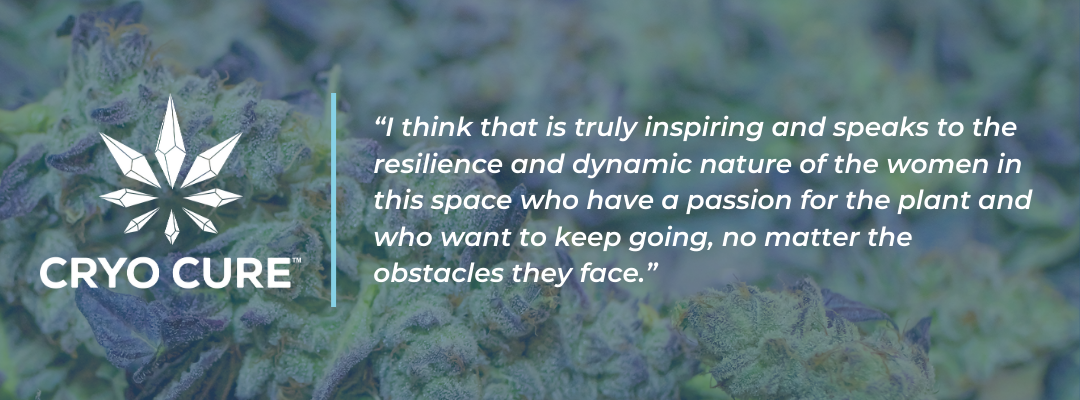At Cryo Cure, we’re redefining what’s possible for the cannabis industry. In this video and podcast series from Cryo Cure founders Tracee McAfee and Greg Baughman, cannabis industry myths are explored, debunked, and retold to help the world understand the ever-changing cannabis landscape and explore the beauty and magic of the plant.
On the inaugural episode of Cryo Cure’s The Cold Truth podcast, Cryo Cure CEO Tracee McAfee sat down with Jennifer Whetzel and Rachelle Gordon, Founder and Partner respectively of the recently published Women in Cannabis study. Passionate about empowering women in the cannabis space, both Whetzel and Gordon have combined their efforts to produce a groundbreaking, mixed-method research project highlighting the unique yet shared experiences of women working in the emerging industry.
Catch a quick summary of that conversation below and watch the full interview on YouTube.
Why women in weed?
On the podcast, Whetzel explained that while data about women in cannabis exists, the Women in Cannabis Study is the most comprehensive dataset that speaks directly to the experiences of women who enter the cannabis industry. When asked what motivated her to create the study, Whetzel said the proof is in the pudding.
“I was thinking about all of the stories [good and bad] that I was hearing on social media about women’s experiences in cannabis,” Whetzel explained. “All of these stories are great anecdotes, but as we know, [and] we keep being told in cannabis, anecdotes aren’t data.”
With a background in marketing, data, and consumer research, Whetzel knew she wanted to gather data that would help her understand women’s experiences, not just working in the cannabis industry, but understanding them as people forming the groundwork of a brand new industry. Whetzel said that information is a must for providing a complete understanding of bringing new women into the cannabis space as consumers, employees, and business owners.
The commonality of consumption
The Women in Cannabis Study recruited participants through social media, word of mouth, and various PR tactics, with around 820 women expressing interest in participating. Following rigorous scientific processes, however, the qualitative interviews narrowed down the pool to 23 ideal subjects. The results were published in a .pdf, complete with video components that interviewed some subjects on camera.
Whether said there were several surprises, with some of the most interesting ones surrounding consumption.
“We did a follow-up study with current and curious consumers in legal states,” said Whetzel. “We talked to thousands of women so we actually could compare ‘industry insiders’ to consumers, those who were curious and have tried before, and those who were curious and never tried before.”
The study found that 69% of industry insiders used cannabis daily compared to 59% of general consumers. And further, tha the majority of women who work in cannabis are using it for general emotional health and wellness, patience, and stress relief.
Representation by the numbers
While both Whetzel and Gordon noted that they don’t see a lot of barricades based on gender, they have noticed a heavy male presence on the cultivation and processing end of the industry. According to Whetzel, the sample indicated that women tend to gravitate towards creative and support roles — with about 23% in retail, 22% in coaching, and just 17% in growing or cultivation roles.
McAfee noted that in about the four years Cryo Cure has conducted demonstrations at their Michigan headquarters, only two women in cultivation and processing walked through the door.
“It’s very few women I see in these positions, which I find surprising in a way. I do, however, see a great deal of women in the purchasing, marketing, and sales areas when I go to the corporate headquarters,” McAfee said.
Despite these smaller numbers, Gordon shared that she found it most interesting that the vast majority of women feel successful in the cannabis industry, even if they feel there’s room for improvement in terms of equity and gender parity.
“I think that is truly inspiring and speaks to the resilience and dynamic nature of the women in this space who have a passion for the plant and who want to keep going, no matter the obstacles they face,” she noted.

Creating space for women’s leadership
While there may not be a clear path just yet as to the best way to create more space for women in C-level positions in cannabis, Gordon pointed to the data in the Women in Cannabis Study as a crucial starting point for this important work.
“I don’t have all of the answers – no one does – but this Women in Cannabis study could be a great catalyst to enact some of that change and develop those answers,” Gordon said.
Whetzel developed a 3-pronged approach to enact change for those looking for direction: finding opportunity within, active allyship, and observing what the cannabis industry can change to help more women advance.
“Consider how your connections and introductions can help others,” Whetzel said.
Listen to the whole interview with Women in Cannabis Study leadership
Each episode of The Cold Truth is released on YouTube. You can listen to the Women in Cannabis Study episode by clicking here. Future episodes will be released across podcast platforms.



